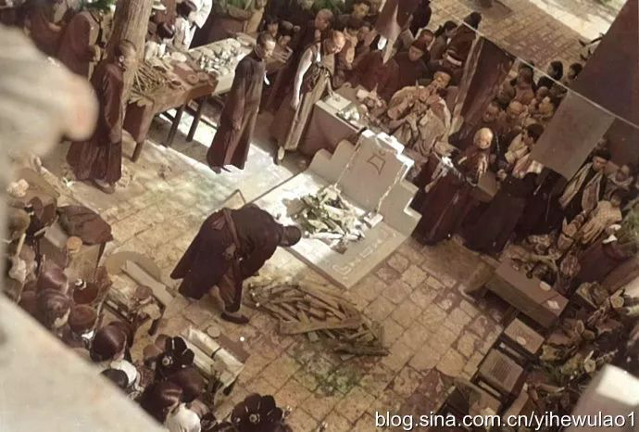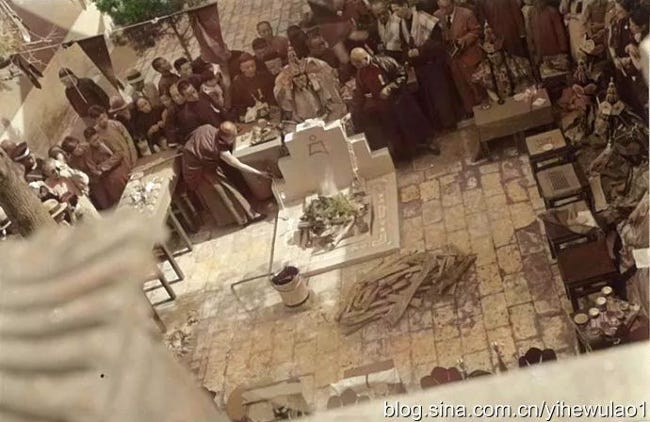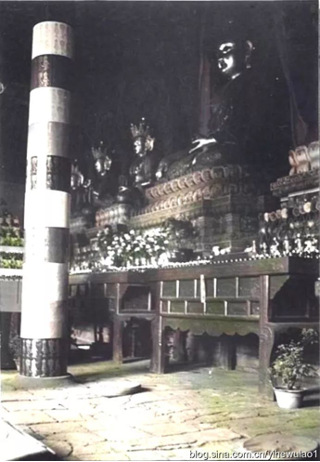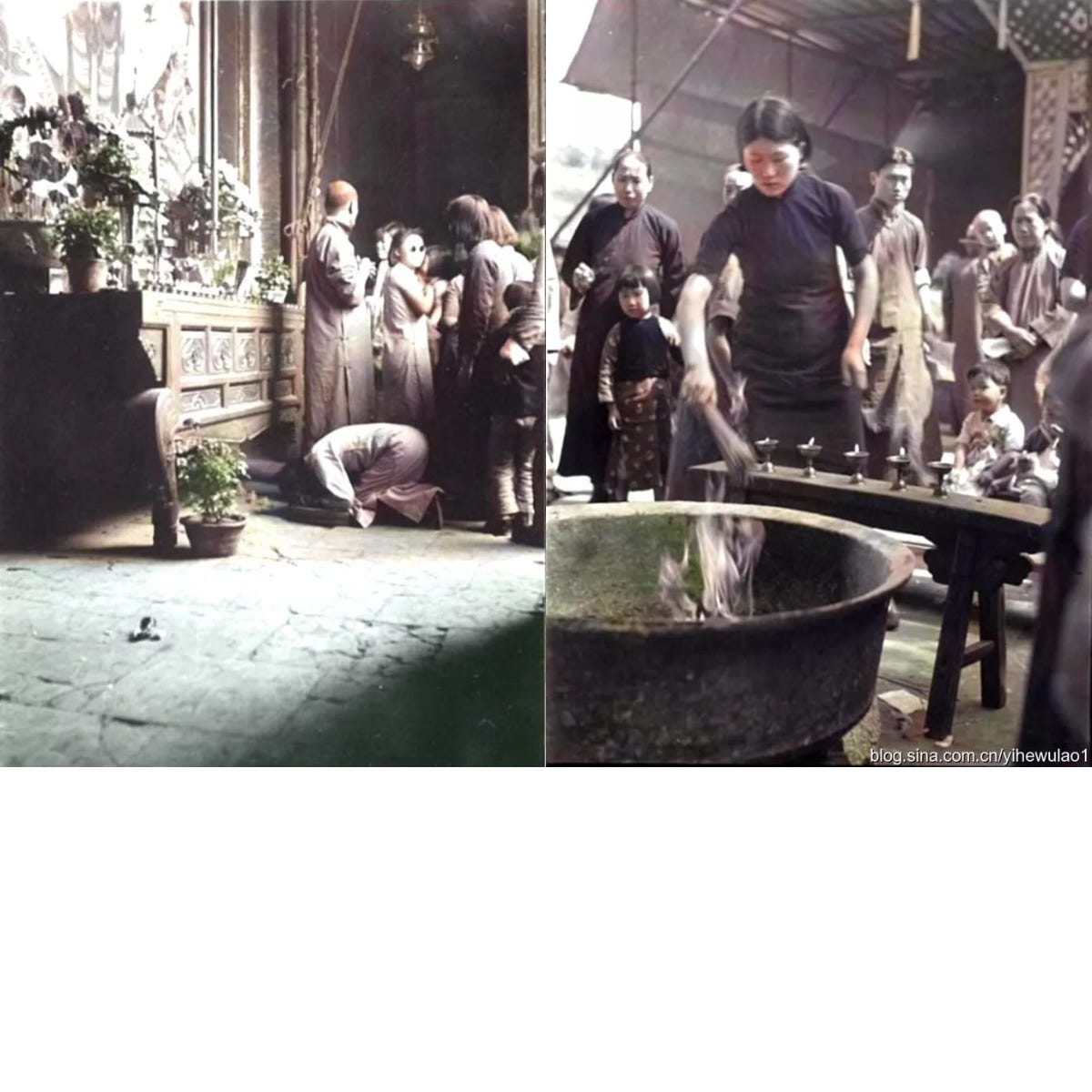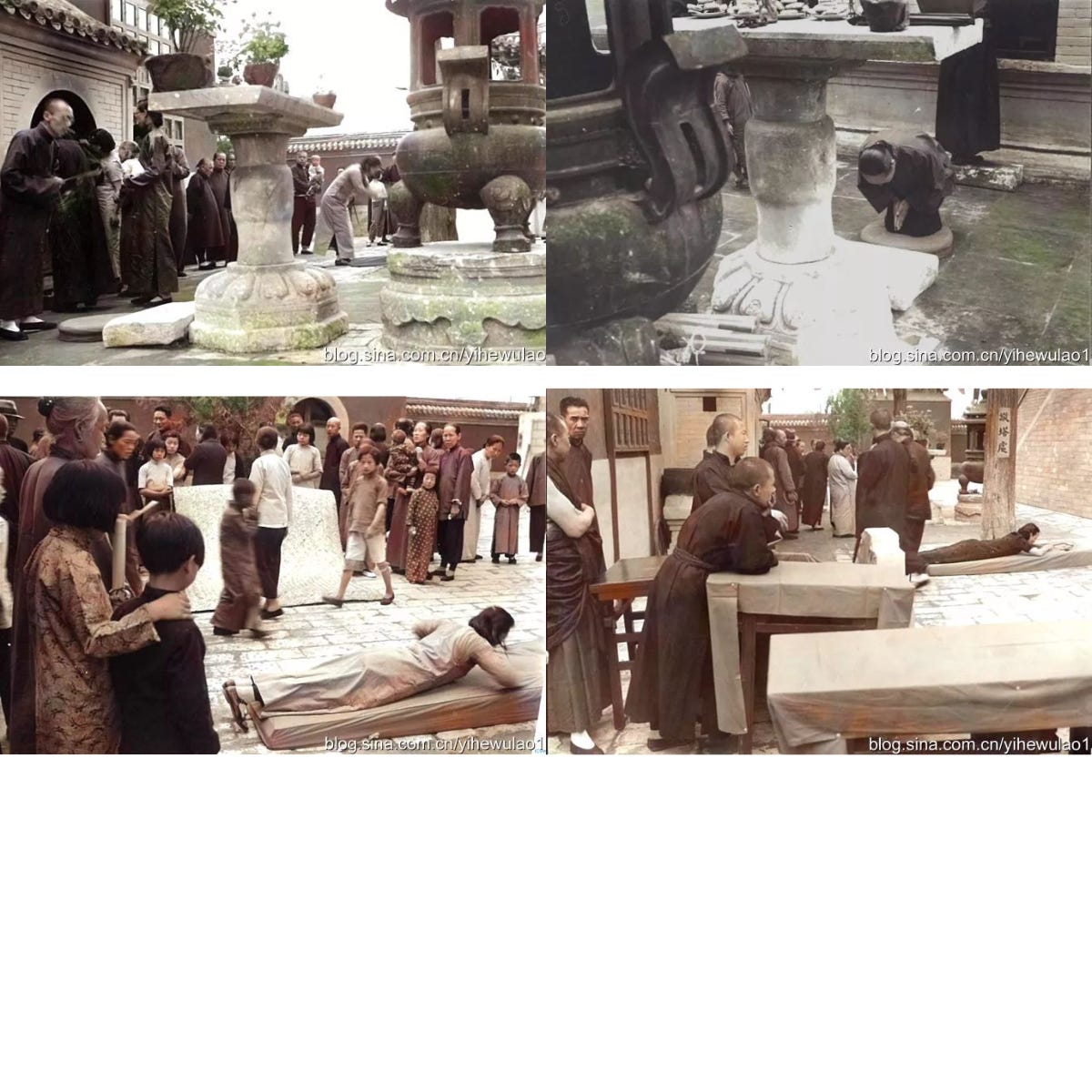【Xiaoqiang Collection】
Collection of rare and precious old photos and introduction articles of Báitǎ Temple[1]
The legend of White Pagoda Temple
There are two white pagodas in Beijing. One is on Qionghua Island in Beihai Park. It is a landmark building in Beihai Park. It was built in 1651 and is a Lama Pagoda with a clear height of 35.9 meters. Below it is a tall masonry platform, and the tower base is a folded-angle sumeru throne, which supports a bowl-covered tower body. The upper part of the tower is a slender thirteen steps, and then there are two layers of copper canopy, fourteen bronze bells hang on the edge, and the top is the gilt flame bead pagoda. Many people have seen this White Pagoda. People who visit Beijing will naturally see the White Pagoda when they arrive in Beihai.
Another White Pagoda in Beijing is larger in scale and has a longer history than the one in Beihai Park. It is the only existing white pagoda since the Yuan Dynasty in China. The gate overpass is about a mile and is called the White Pagoda of Miaoying Temple (妙应寺). Built in 1271, Araniko, a master craftsman from Nepal, participated in the design and construction. One of the important projects when Kublai Khan, the ancestor of the Yuan Dynasty, built the capital city.
At that time, it was called "Dashengshou Wan'an Temple"(大圣寿万安寺). In the first year of Tianshun in the Ming Dynasty (1457), it was renamed Miaoying Temple.
The temple consists of a four-story hall and a pagoda. The tower is 50.9 meters high, and the tower base is a three-layer square angled sumeru throne. The top is a covered lotus seat composed of semicircular protruding lotus petals and a ring-shaped diamond ring supporting the tower body. A canopy covered with 40 radial copper tiles, around which hangs 36 copper openwork fringes and wind chimes with a height of 1.8 meters and hollow patterns, about 5 meters high and weighs four tons. What is particularly striking is that there are seven iron hoops surrounding the fat bowl-shaped tower.
Because these seven iron hoops are wide circumference and several tens of meters above the ground, which is beyond the reach of ordinary manpower, later generations are often puzzled - why should a good white pagoda have iron hoops that do not look good? Who can put this iron hoop up?
After the White Pagoda of Miaoying Temple was built, the breeze blew, and the bells sounded clear and melodious. Many upset people heard the melodious bells and unconsciously the center became calm and quiet, and the surrounding people enjoyed it. The incense of White Pagoda Temple is so strong. Good men and women burn incense and pray to Buddha for peace. It is quite effective, and it has become a good place for the people of Beijing to visit.
Suddenly one day, with the terrifying screams of beasts rumbled from the ground, the mountains shook, and an unprecedented earthquake occurred in the city of Beijing. The smoke and dust rose up, because there were too many collapsed houses, the sky was dark and the ground was dark in an instant. People in the city were running around, most of them were unsteady, and had to roll and crawl. Together, his tragic state could not bear to watch, shrill of voices could not bear to be heard.
Just when the people in the city were facing a tragedy, there was another violent continuous explosion from Xuanwumen (宣武门). It turned out that a firecracker workshop was due to an earthquake and the gunpowder collided for no reason, causing three consecutive explosions, billowing black smoke straight into the sky.
After the earthquake, it was found that several large cracks appeared in the White Pagoda of Miaoying Temple. It looked as if it could fall apart at any time. This is incredible. If the upper half of the White Pagoda falls, it will not be able to raze the surrounding people to the ground, and the newly repaired house will be smashed. Every day, people from three floors watching from a distance. They want to move but have nowhere to go. If they don’t move, maybe these hundreds of thousands of kilograms of stones and copper canopies will fall, not only the house can’t be saved, but also the life. They couldn’t play with their life. Seeing that the cracks are only widening and not closing in, the common people lost appetite. While looking for someone to repair it, it is so old and big that even if the emperor issued an imperial decree, is useless - who would build a white pagoda with a diameter this big? Everyone had no choice but to suffer day by day. Originally, when the wind blew and the bell rang, it was a treat for the local people, but not anymore. When the wind blows, everyone hurried to leave their jobs and ran to the open field. They couldn't even eat and sleep because they were afraid the wind will blow the White Pagoda down!
On this day, at noon, the sun was particularly lethal, and the cicada cried out with a long and short sound. Usually, people hid under the big trees to sleep in the shade, but now they can’t. They have to hold their heads up and watch when the White Pagoda will collapse and take the time to hide.
When people were bored, they heard someone shouting on the street: "Here, big guy, big guy..." It was even louder than ever.
In the days of the earthquake, there were many people's water tanks, flower urns, and large tile basins that were accidentally damaged when they were sheltering from the earthquake. When people heard that there was a master of the curium, many people came out from every household to ask.: "The water tank in our house is half the height of a person. How much would you pay for it?" The man replied, "The water tank is too small.
" Another person asked: "The pot, the big flower tank for goldfish in my house is much bigger than the water tank in their house. Do you use it?" "Answered:" No, I'm specializing in curium.
"The water tank and fish tank are the largest in the common people's house, and he didn't give them the curium. Some people were unhappy and said, "Go!" go! Go to a cool place where no one is there, the water tank is not big? What are you making a mess here, you didn't see the big guy being upset? "Someone said a wit: "curium guy? The White Pagoda Temple is big, with so many cracks, look up and see, have you cut it? The people around laughed sarcastically, and when everyone's laughter subsided, the man took out a sweat pot, filled it with shredded tobacco unhurriedly, came over and said, "Old and young men, borrow a fire, I really didn't blow it, I just came for this cracked white pagoda..." As soon as he said this, the big guy was stunned, "What? can you add the curium of the White Pagoda Temple on the White Pagoda? "The old man took a few puffs of dry cigarettes, knocked off the ash, and then filled a pot again. This time, without him talking, someone automatically set the fire with a scythe and helped him light the cigarette.
After smoking three pots in a row, was over the habit of smoking. At this time, someone had already brought up the cold tea. The old man drank a few sips of tea and said, "The villagers are really not bad to me, just rush this fire and this tea, no matter how difficult it is, I will also put this white pagoda on top, and you will make me a few pots of molten iron from tomorrow, make a few big iron hoops and put them at the bottom of the tower, and you don't have to worry about anything else."
In the following days, the old man appeared on the iron-making site on time every day, instructing everyone on how to make iron hoops. Since everyone was eager to relieve the danger, no one asked him his origin. By the time the iron hoop was ready, it was already autumn, and it was getting dark early. When it was finished, a wealthy household sent over a dozen baskets of good liquor for the people who had been busy for a long time to drink and enjoy. After having a full meal, everyone went back to their respective homes to rest early.
At dawn the next day, everyone looked up and saw seven iron hoops tightly and evenly hooped on the White Pagoda. People started to talk about it: there was no movement last night, not even the minimum scaffolding, how could it be fixed? When it was time to eat at noon, everyone prepared tableware for the old man, but the old man was not seen for a long time. Someone said: I think that the old man must be the reincarnation of Lu Ban (鲁班), who specializes in solving problems for us ordinary people, or who else? With such a great ability, he can add iron hoops to the white pagoda several feet thick!
This is the legend of White Pagoda Temple!
(Xu Xudao's talk to Beijing 2017 program manuscript)
**
Hedda Morrison
A group of old photos of Miaoying Temple
1938 Beijing White Pagoda Temple Tantric Consecration Ceremony
The old photo of the consecration ceremony was taken by the Japanese in 1938, and the date is May 1938 (lunar calendar?). There are many believers who participated in the ceremony, not only Han but also Mongolians; not only those who worship the pagoda, but also those who kowtow around the pagoda.
Miaoying Temple, commonly known as Baita Temple, is located at No. 171, Fuchengmen Inner Street, Xicheng District, Beijing. It is a Gelug monastery of Tibetan Buddhism and is now open to the public as a museum. The temple was built in the Yuan Dynasty and was originally named Dashengshou Wan'an Temple. The White Pagoda built in the Yuan Dynasty is the oldest and largest Tibetan Buddhist pagoda in China.
In 1961, "Miaoying Temple White Pagoda" was announced by the State Council as one of the first batch of national key cultural relics protection units.
Devout believers. It is said that the followers are wearing Buddhism conversion badges around their necks, and immediately feel that the aesthetics during Republic era was awesome.
From the end of the Qing Dynasty to the period of the Republic of China, Miaoying Temple was a very formal monastery of the Gelug sect of Tibetan Buddhism.
In 1906, the Lama Printing Office (喇嘛印务处)requested that the lama of Hongren Temple弘仁寺(Xi'an Gate, Beijing), which was burnt down in 1900, be transferred to Miaoying Temple. In 1936, during the survey and registration of temples in Peking, there were 16 resident monks in Miaoying Temple, and Lama Zasak of Tongfu Temple同福寺(Beijing) also took charge of the temple affairs.
Previously, many monks in Miaoying Monastery studied Manchu Buddhist scriptures, but since 1936, they have all been changed to Tibetan Buddhist scriptures. In 1946, when the investigation and registration were conducted again, the number of resident monks in the temple was not reduced, there were 1 Zasak (Lashidamba, the Lama Zasak of Tongfu Temple, who was also in charge of Miaoying Temple). There were 2 ge sigui格斯贵(Bataan巴丹and Shuangxi双喜, both are Ge Sigui from Ciyou Temple慈佑寺). In 1946, the Peking municipal government abolished Tongfu Temple and Ciyou Temple, and the monks merged into Miaoying Temple.
According to the archives of the Second Historical Archives of China, in the second year of the Republic of China (1913), the lama in charge of White Pagoda Temple asked the Mongolian and Tibetan Affairs Bureau to "receive the rent of the temple to finance repairs", which was approved by the Mongolian and Tibetan Affairs Bureau with five or six days to attract investment and collect rent. As a result, the White Pagoda Temple fair began.
The White Pagoda Temple fair was held every month on the fifth and sixth days of the lunar calendar (ie, the fifth, sixth, fifteenth, sixteenth, twenty-fifth, and twenty-sixth days of the lunar calendar). The temple fair is held on 6 days a month, and since 1922 which was changed to the 5th and 6th day of the solar calendar.
When the White Pagoda Temple Festival is held, the temple and the alleys around the temple are full of vendors, entertainers, etc. There are food and entertainment, and it is very lively.
After the founding of the People's Republic of China, the land temple fairs were suspended, the flower market was changed to a long-term market, and the White Pagoda Temple fair was changed to every 3rd, 4th, 5th, and 6th, with a 12-day temple fair every month. It was gradually suspended during the three-year difficult period from 1958 to 1961, and has not resumed since then.
*** This is Part 1 of 3 part series on the historical photos and significance of the Báitǎ Temple (or Miaoying temple). The Part 2 of the translation will be released tomorrow.***
The link to the original article can be found here
[Please note: If you are interested to reproduce our translation works, please let us know in advance. Contact us: thearanikoproject@gmail.com for inquiries]
[1] Bái tǎ sì (白塔寺)= White Pagoda Temple, is the neutral name used to address the Miaoying Temple today which was renamed during the Ming Dynasty.














